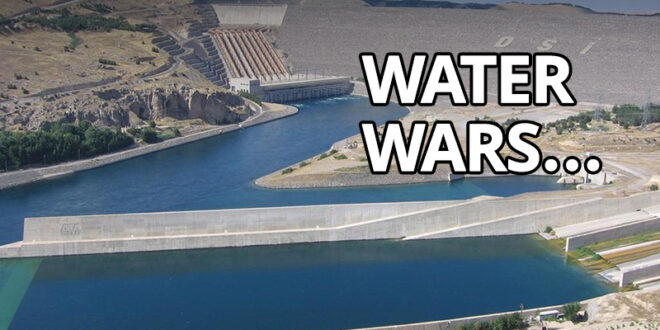Mouood: Tensions and conflicts over water in West Asia and North Africa have taken on new dimensions in recent years, and countries are trying to capture as much of their shared water resources as possible.
Water wars and the countries’ policy
According to Fars News Agency International Group, one of the issues that direct the countries’ policy and their behavior towards each other in the region of West Asia and North Africa, is the issue of water and the concern of safe access to it. In a previous article, we addressed the issue of water scarcity in the region, noting that more than 26 countries in the world are short of water, of which nine are in West Asia. Thus, when there is a valuable and vital element with few resources, governments will inevitably be drawn into the conflict, tension, and even crisis, even if they have good relations in other areas.
Almost all countries in the region are facing increasing population, drought, soil erosion, and declining food production. Therefore they are forced to deal with neighboring countries to prove their claim to water rights. This situation is intensifying day by day.
Sovereignty over water resources is one of the geopolitical issues that are difficult to solve. The movement of water as a source of fluid within aquifers or on the surface of the earth in the form of rivers has caused water to cross the conventional borders between countries. The performance of upstream countries can have devastating effects on downstream users.
Here, Turkey’s policy of building dams on the Tigris and Euphrates rivers and its impact on Iraq, Syria, and Iran, or the flooding of the Al-Nehza dam on the Nile River and Egypt and Sudan’s strong protests against Ethiopia are clear examples of this in West Asia and North Africa.
Based on the assumptions of the theory of realism and an interest-based approach, and given the limitations and value of water, water scarcity generally does not lead to cooperation and assistance of countries to overcome it, and vice versa causes conflict and crisis. We may see a war over water in the future. As in the case of the Al-Nehza Dam, we witnessed at one point the military threats of Egypt and Ethiopia against each other.
In particular, international law has so far failed to establish a treaty to protect the water rights of states. Another issue is the use of water and geographical advantage as a weapon by countries and regimes located in the upper reaches of rivers. The treatment of Jordan by the Zionist regime towards the Jordan River can be a good example of this issue.
In this article, we will try to address the three water-stressed watersheds in West Asia and North Africa, namely the Tigris and Euphrates, the Jordan River, and the Nile, and examine the behavior of governments towards gaining more share of water as a vital element.
Tigris, Euphrates and Nile rivers
The Tigris and Euphrates, and the Nile rivers, are the three largest rivers in West Asia. The region between the Tigris and Euphrates is historically known as Mesopotamia (modern-day Iraq). These two rivers originate in southeastern Turkey. The Euphrates flows from Turkey to Syria and then to Iraq.
The Tigris also originates from the Terror Mountains in Turkey, after traveling 1850 km, it merges with the Euphrates River and flows into the Arvand River, and finally into the Persian Gulf. 22% of the length of the Tigris River (400 km) is located inside Turkey and 52% (240 million cubic meters) of its inlet water is supplied from Turkish water sources.
Turkey has a major conflict with Syria and Iraq over the Tigris and Euphrates rivers. The country has been implementing a strategic project called GAP (Guneydogu Anadolu Projesi in Turkish, abbreviated GAP) since the 1980s. The original idea for such a project dates back to 1936. The Turkish government claims that the project aims to reduce regional deprivation by increasing incomes and living standards, as well as increasing social stability and economic growth, and job creation, especially in rural areas.
The project covers nine provinces in Turkey, including Adiyaman, Batman, Diyarbakir, Gaziantep, Kilis, Siirt, Shanli Urfa, Mardin, and Sharnak, located in the Euphrates and Tigris rivers and the northern Mediterranean. Under the project, Turkey will build 22 dams and 19 power plants on the Tigris and Euphrates, most of which have already been implemented and built, significantly reducing water entering the Tigris and Euphrates in Syria and Iraq.
Since these two rivers constitute 98% of Iraq’s water resources and 90% of Syria’s water resources, the two countries consider this project a serious threat to their water resources. Turkey inaugurated the 1400 Ilisu Dam on the Tigris River on 15 November. The dam, experts say, poses a serious threat to agriculture and the environment in Iraq and possibly Iran.

“We must do everything in our power to protect our country from the food crisis caused by the drought and similarly to the growing energy crisis,” Turkish President Recep Tayyip Erdogan said in a speech at the inauguration of the Ilisu Dam. “It is an observation, let us use it.” “We cannot waste a single drop of our country’s water resources,” he continued.
“We also need to maximize the production of renewable energy based on our resources.” It is well known that in the minds of the Turkish authorities, the entry of the Tigris and Euphrates waters into Syria and Iraq means the loss of water.
The Turkish government has also refused to accede to the Convention on the Non-Shipping of International Watercourses. The convention was adopted in May 1997 in New York and is the only international document governing the world’s common freshwater flows.
The convention obliges states to use shared water resources “fairly” and refrain from harming each other. Turkey claims that the convention on the Tigris and Euphrates is in favor of the downstream countries and is in their interests. It seems that Turkey is trying to use all-natural and unnatural opportunities and facilities to impose itself on the countries of the region. Here we are dealing with the issue of geography as a lever of power. Is Turkey trying to prepare for the future of the region and increase the water shortage crisis and take control of the region’s water?
The Jordan River Basin
The Jordan River Basin is shared between Jordan, the Zionist regime, the West Bank, Syria, and Lebanon. The river is 360 km long and has an annual flow of 1.3 billion cubic meters. It originates from Syria and Lebanon and flows to the south. It flows again from this lake and leads to the Dead Sea. The river also forms the Jordanian border with occupied Palestine and has been one of the watersheds of tension and crisis for the past century.
The Jordan River has two parts, Upper Jordan and Lower Jordan; Upper Jordan River, which stretches from the source to Lake Tiberias, and Lower Jordan River, located between Lake Tiberias and the Dead Sea.

The crisis began when the Zionist regime diverted the upper Jordanian waters and took them to central and southern occupied Palestine for Zionists’ use. Lake Tiberias, a source of freshwater, provides more than two-thirds of the water needed by the inhabitants of the Occupied Territories and is therefore of strategic importance to Tel Aviv.
In 1964, the Israeli regime implemented a water supply project from Lake Tiberias, when the amount of water entering the downstream was drastically reduced. The Arab League then convened and called for a boycott of the plan. In Syria, it was decided to cut off the source of the lake from Syrian territory.
In the same year, the first clashes between the Syrian army and the Zionist regime took place around Lake Tiberias. The Zionists sought to increase their share of the lake, so in the war that took place three years later in 1967, the Israeli army was able to occupy the entire Golan Heights.
The consequence was the entire dominance of this regime over Lake Tiberias, thus gaining a very important lever to put pressure on Jordan, which is located downstream of the lake. There have been many plans for water distribution in this basin. One of which was the plan of Johnston, the representative of Eisenhower, later the President of the United States (in 1953). According to this plan, the share of water from different sides of the Jordan River basin was agreed as shown below:
| The share of water in the Jordan River (Mm/yr.) | |
| Palestine | 257 |
| Jordan | 463 |
| Zionist Regime | 40 |
| Palestine | 132 |
| Lebanon | 35 |
| Total | 1287 |
But over the years and the occupation of the entire area of Lake Tiberias and the Zionist piracy, the countries’ share of the Jordan River water is now very different from Eisenhower’s representative, as shown in the table below:
| The share of water in the Jordan River (Mm/yr.) | |
| Zionist Regime | 700 |
| Palestine | 0 |
| Jordan, Syria and Lebanon | 410 |
| Total | 1110 |
As a result, in terms of access to water resources, Jordan is currently one of the poorest countries in the world. Some villages in Jordan can connect to the drinking water grid for only eight hours a week.
According to the Ministry of Water, the country needs 900 million cubic meters of water, of which it has only been able to obtain 400 million cubic meters. Based on the 1994 “Wadi Arabah Compromise Agreement” the Zionist regime promised to draw water from the Jordan River and send it to Jordan during the drought season. But under Netanyahu, Jordan could hardly meet part of its water needs. The former Zionist prime minister had repeatedly threatened to “leave Jordan thirsty.”
Amman has also sought to buy water from the Zionist regime in recent years. After two years of struggle and consultation, the Zionist regime and Jordan finally signed an agreement on October 11 to increase the amount of water entering the occupied territories from Jordan. Jordan, Israel, and the United Arab Emirates also signed the agreement on water energy at the presence of John Kerry, the US government’s representative for climate affairs, on December 22, which was met with a strong reaction from the Jordanian people and groups, and thousands on Friday.
They took to the streets. According to the agreement, an Emirati company is to build a solar farm in the Jordanian desert with 600 megawatts capacity of electricity, for export to the Zionist regime, in exchange for which the Zionist regime will transfer 200 million cubic meters of treated water to Jordan. Therefore, water plays an active role in the policies of the Zionist regime towards the surrounding countries. It is one of the reasons why the Zionists strongly oppose any plan to return the Golan Heights to the Syrian government. Tel Aviv has also been able to use the water lever to control the Jordanian government.
The Nile Basin
The Nile, the longest river in the world throughout history, has been the source of life in its basin, especially Egypt, and today 95% of the country’s population lives around the Nile. Eleven countries are located in the Nile Basin, including Sudan, Ethiopia, Tanzania, Kenya, Uganda, Congo, Rwanda, Burundi, Eritrea, and the Central African Republic, of which Sudan, Ethiopia, and Egypt have the largest basin area, respectively.
They have given place. Sudan covers 64.63%, Ethiopia 74.11%, and Egypt 14.9% of the Nile. As mentioned, this river is the source of life for Egypt, Sudan, and Ethiopia, and perhaps no country like Egypt depends on this river for its life and death. Meanwhile, the Ethiopian government’s decision to build a dam on the Nile River over the past decades has always met with a strong reaction from Cairo, although Addis Ababa has finally resisted these pressures and completed the construction of the dam.
Although about 9% of the Nile area is located in Egypt and 95% of its source is outside this country, 97% of its water is exploited in Egypt. The country has a dry climate. All Egyptian agriculture and industry depend on the Nile water and the Aswan Dam (with a capacity of 169 billion cubic meters) built on the Nile River between Egypt and Sudan.
On the other hand, the annual population growth of Egypt is 2% and one million is added to its population annually. It is predicted that by 2025, Egypt’s population will reach 95.9 million, which indicates the growing need for Nile water resources. In this regard, we should mention the words of Abdel Fattah Al-Sisi in 2015, when he signed an agreement (albeit unsuccessful) with Ethiopia, which said: “The Ethiopian people should remember that the life of the Egyptian people depends on the Nile River…”
However, the construction of the Al-Nehza (or Renaissance) Dam has been completed despite all the objections of Cairo. The first phase of its dewatering has been completed. With the dam completion, Egypt will lose 20% of its share of the Nile.

Many reports on international crises suggest that they will enter the crisis if the three countries do not reach an agreement before the dam is built. Building this dam could be a nightmare for the Egyptians. Egyptians are so concerned that the late Egyptian President Mohamed Morsi officially threatened Ethiopia with a military strike in 2011, saying: “As president, we will resort to the military option if necessary.”
“The Nile River is a blessing for Egypt…” After the coup and the ouster of Abdel Fattah al-Sisi, he tried to change his tone and enter into dialogue, and the Cairo efforts eventually led to an agreement between Egypt and Ethiopia in 2015, but the agreement remained on paper and was never implemented. . So far, not all mediations, including the United States and the African Union, have reached an agreement between the three countries.
On May 7, 2017, an Eritrean website announced the military readiness of Egypt and Ethiopia for a military confrontation and wrote that Egypt is a threat to Ethiopia with the purchase of 24 Rafael jets from France, while Sudan and Ethiopia are on standby. Therefore, military threats may remain. But if the dam is finally flooded, regardless of Cairo’s concerns, we will have to wait for Egypt’s tough response.
And in the end, West Asia is home to six percent of the world’s population and only one percent of the world’s freshwater, so countries in the region must make a vital decision to bridge the gap between water demand and supply. In addition to adopting policies and measures to reduce water wastage and efficient consumption, in the external arena to cooperate and assist to protect the environment.
Many scientific circles have long believed that future wars will be over water and food resources. The population is increasing in all countries and water resources are also decreasing due to irresponsible human behavior.
 Mouood Mouood English Edition
Mouood Mouood English Edition




